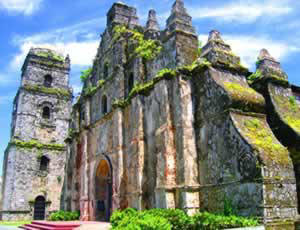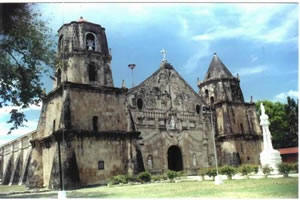|
When in 1521 Magellan lands on Cebu, also monks are in his retinue. The conversion to Christianity is one of the main objectives of the conquerors besides the (mostly unsuccessful) exploitation of the countrys raw materials. Bajo de las campanas- the natives have to be taken under the bells. Priest and monks are in need for places for their religious meetings. The first accommodations are quite modest wood or bamboo huts with straw or nippa-palm roofs ("Visitas"). Some monks know imposing Mexican baroque churches, either real or by illustration, but why should they invest more? The financial resources are very limited, the political situation still unstable (Moro attacks, Portuguese territorial claims), and in addition, the apocalypse and the arrival of the Lord is expected again. The first chapels made of wood are built on Cebu, Bohol, Masbate and Manila between 1565 and 1571. Their temporal sequence is a little bit uncertain because in such time, no signposts inform about the year of construction and the documentation of the church still stands at their beginnings. In the following period, the early infirm lumber chapels become dilapidated or are replaced by stone churches. The construction of stone churches - baroque structure and style elements The construction of stone churches begins as of 1571 with the establishment of the colonial regime by Legaspi. The architectural style is orientated on the Spanish or Mexican baroque. The first master builders and artisans are mainly coming from Mexico. That is not surprising because the colonization starts from Mexico. As a rule, we find the followings baroque structure elements:
The construction of churches has to consider the special conditions of the country: natural disasters (typhoons and earthquakes), natural calamities (tropical weather, rottenness, and termite attacks) as well as human destructions (pirate attacks, conflagrations). That is the reason why the Philippine church architectural style, which sometimes reminds also of medieval defying castles or citadels, got the name "Earthquake Baroque". The Philippine Earthquake Baroque is due to these specific considerations and variations not only a bare plagiarism of Spanish baroque churches. Enrichment by Asian Moorish style elements Furthermore, the integration of Chinese and Muslim forms and style elements is a characteristic feature of the early church building. At first, the Filipinos are inexperienced in the construction of stone buildings. Only the south of the country knows fortresses of the Moros. The Christian monks therefore call on the help of Chinese and Muslim master builders and artisans. Chinese influence is indicated for example by :
Characteristics for Moorish Islamic style elements are:
There are reports about compulsorily recruitments of Philippine construction workers. Often they are responsible for the cutting, transport and processing of the big tree-trunks, which become church columns. Destructions In spite of all efforts for more stability, the built churches remained frequently fragile objects. In the course of the history, many of them suffered much destruction and new buildings become necessary. Here two examples of the continuing building process:
Oldest Church? There was a dispute a while ago, which stone church is the oldest one in the Philippines. Particularly the Baclayon Church on the island of Bohol and the San Agustin Church (Manila, Intramuros) were under discussion. First, it was supposed that the Baclayon Church is the oldest one, because a sign on the façade showed the year 1595. The tourism industry on Bohol was very happy about this indication. However, later investigations discovered that this sign has been attached considerably later. By now church historians discovered in the San Agustin Church (Intramuros), a foundation stone from the year 1571 and this date is 25 years earlier than the sign of Baclayon. Therefore, the honor of being the oldest stone church in the Philippines is due to San Agustin. Some describers are writing a little bit emotionally and perhaps untrue that it is the mother of all Philippine churches". Cultural Treasures The San Agustin Church has resisted since the 16th century all earthquakes and later World War destructions especially by its curved thick foundation and inside buttresses. Nevertheless the today built is also a result of continuing remodeling and renovations. In the rule most of old Philippine churches have passed a steady process of rebuilding, preservations, expansions, renovations (embellishments) and in this process also newer style directions (e.g. neo-Gothic, Ionic, Corinthian style elements) were integrated. In a negative sense, it is frequently an eclectic Pseudo baroque. In positive sense, we can also talk about a unique fusion of different European-Asian construction styles from different epochs based on Spanish baroque. Since 1972, 26 old churches have been declared as national cultural treasures. The following churches are belonging to these 26 churches worth of further protection: Bacong (Negros Oriental), Balayan (Batangas), Betis (Pampanga), Boljo-on (Cebu), Calasiao (Pangasinan), Dupax (Nueva Vizcaya), Guiuan (Samar), Jasaan (Misamis Oriental), Jimenez (Misamis Occidental), Lazi (Siquijor), Loboc (Bohol), Luna (La Union), Mahatao (Batanes), Magsingal (Ilocos Sur), Majayjay (Laguna), aragondon (Cavite), Masinloc (Zambales), Pan-ay (Capiz), Romblon (Romblon), Rizal (Cagayan), San Joaquin (Iloilo), Tabaco (Albay), Tanay (Rizal), Tayabas (Quezon), Tayum (Abra) and Tumauini (Isabela). And not only the Tubbataha Reef, the Rice Terraces of Banaue, the historical old town of Vigan and the Puerto-Princesa Subterrean River National park is part of the world cultural heritage exclaimed by the UNECO - four churches in the Philippines are also regarded as unique and of universal value. These are the churches:
Each of the churches mentioned above is worth a special consideration and every selection is subjective. We have decided to give our attention to the churches in Paoay and Miag-ao particularly because of their historically unique old substance. The Miag-ao Church on the island of Panay
Highlight of the yellow sandstone church is the rich The good missionary brings the true faith to the heathen Filipinos in the tropics world. Two non-symmetrical towers anchor and protect the front façade. They are very massive in the lower parts and then tapering upwards and served as watchtower against Muslim encroachments at the same time. Why are they not symmetrical? The explanation is simple. After the death of the first master builder, the second master builder did not want to follow the design of his predecessor. Also this ecclesiastical building has on its sides solid buttresses, which are so typical for the "Earthquake Baroque". Underground walks connected the church with the municipality. We mentioned already that the church belongs to the UNESCO cultural heritage. The Paoay Church in Ilocos Norte
Under the management of the Augustinian monk Antonio Estavillon, the construction of this, a Javanese temple reminding, majestic church started in 1694. The plan was to set up an earthquake-proof and simultaneously imposing building in the style of the "Earthquake Baroque". In 1710, the majestic impressive church was completed; however, already in 1793 restored and newly dedicated in 1896 as "Church of St. Agustin". Coral stones were used for the building of the upper parts, bricks for the upper levels. To the mortar was added sugar cane juice and sometimes leather stripes to increase the stability of the building. The façade shows a vertical structure by four wall columns, it is horizontally subdivided by ledges, which also orbit the buttresses. We find tapering turrets at the top of the building. An author formulated - they are brushing the sky- and they are lifting the heaviness of the building. Some sculptures and relief models - flowers, snails, Cherubim and the Augustine's coat of arms are found in the upper part of the façade. The 26 solid pillars are spectacular. They reach in their breadth almost half the length of the nave and are adorned with snails, floral patterns, and show turrets likewise. Pillar stairs with rather high steps should allow the access to the roof, which was originally covered with straw. Another feature is the massive belltower. It is 35 meters high and the walls have a thickness of one meter. It stands about hundred meters remote from the church and offers an excellent view over the country. The Katipuneros, revolting against the Spanish colonial regime, used it as a watchtower. Climbing the belltower is almost like going back in the time, writes Roger Gaspar (3). It is reported that due to its heaviness it is gradually sinking deeper into the ground. In the past, riders still have ridden by the tower gate. Today that seems to be impossible. The church door is provided with a wrought-iron filigree decoration. Going inside we see a very simple -- if not even dreary -- church interior with some saint pictures and a simple wooden altar cross. Originally, the nave had a painted wood ceiling. It was removed in earlier time and today only rafters and a rusting roof can be seen. Undoubtedly, the Paoay Church was neglected in the past with regard to its historical substance. This fact becomes also evident by the strong green and bush vegetation, which can be seen in current publications. However, after the church was declared as World Cultural Heritage, first steps for the preservation of the church have been starting in 2000. The catalogue of measurements includes among other things a seismic expertise, rip and stone mending and cleaning works, i.e.. the removal of vegetation. Because of possible concussions the traffic is now diverted nearby the church, too. These remarks brings us to the general question about the present state of preservation and restoration of the old churches in the country. Enormous restoration and preservation effort Old buildings are exposed to many destructive influences. Wood gets brittle, is sagging and water logging, forms rips, becomes rotted and is affected by termites or mildew. Stone material can break out, form rips, draw water, extract salts, lose the color or become overgrown by vegetation. Glass breaks and metals rust or tarnish. The colors of the wall paintings for example are bleached, drop off, suffer from mushroom attack or tend likewise to rips. If no conserving measures are taken, clear marks of the morbid dilapidation can be seen, as in the case the Paoay-Church. The damages are on the one hand caused by nature. Particularly the extreme, humid heat of the country is a harming factor besides natural disasters like earthquakes, floods and typhoons. On the other hand, also man is responsible for the destruction of the buildings. We want only to list the keywords: Air pollution, vibrations, war, vandalism or indifference. There is a broad consensus in the country that the old churches are generally in lamentable conditions. "Sometimes it feels ace if our churches were under siege, declare says Augusto Villalon (4) in his article "Have Mercy on our churches". Surely, the old churches are also symbols of a clerically covered colonialism but even strict critics of the Spanish colonialism reach an agreement in the assessment that the old Spanish churches belong to the historical cultural treasures of the Philippines and need protection. Financial difficulties, ignorance and negligence on the municipality level often prevent measures of conservation. Perhaps we should put ourselves in the role of a pragmatic priest, which has no special relationship to the history and who has to think twice about every penny in his poor parish. Why not removing the old uncomfortable church chairs if a noble patron offers new modern chairs with his nameplate? Why rejecting an offered plastic Madonna if the parish is getting a donation? The old floor creaks - why refusing offered cheap tiles? Moreover, is the old light not so bad that neon lamps would be a good alternative? Why not adding an outbuilding for the youth group? Who still wants to preach from a pulpit and does the choir really still needs a gallery? Did not the antique dealer offer a larger sum of money the old maggoty statue of Maria? The church area is spacious - why not giving a fast food shop the permission of settling? Money has no smell and perhaps the church is then more attractive for young peoples? What are more important - urgent needs or an alleged art? You see also philistine priests can have arguments. At the same time, there are more and more reports on increasing art robbery also in churches. Trixie Angeles, director of the Philippine Heritage Conservation Society, told: "We are losing two containers vans of our cultural treasures each day from the Island of Bohol alone"(5). Religious cult objects are included in the robberies. Priests, as in Majayjay, already safeguard precious relics behind unsightly bars. Some parishes have already decided to deposit valuable objects d'art at central places and to leave only replicates to the churches. It seems that all measures which trying to establish the early original state if there are still historic documents are most expensive. All measures, which serve - by using modern, economic materials - merely the preservation of the status quo, the embellishment or a better functioning, are cheaper. Perhaps in time of Spanish colonialism with its unity of state and church and royal patronage funds, the financing of church buildings was easier. Later the American invaders brought the separation from state and church in the country with the consequence, that the Catholic Church of the Philippines is at first responsible for the maintenance and repairs in the churches. Nevertheless, since the time of Marcos the governments feel also responsible the conservation and they are giving institutional and financial supports. May be that there are already too many institutions taking care for the conservation (Roman Catholic Church, National Historical Institute (NHI), National Museum, National Commission for Culture and the Arts (NCCA). Many institutions many time-consuming consultations. As far as we can see it up to the year 2003 - the preservation efforts with regard to the 26 precious churches are underway. However, they are mostly still in the phase of measurements, feasibility studies", cleaning and de-weeding and tend to preserve and to embellish only the status quo. The help of the foreign countries would also be desirable to encounter the further dilapidation of the old bastions of the Roman Catholic faith in the Philippines. © Wolfgang Bethge, 2006 (1) It is told, that for the construction of the Baclayon Church (Bohol) in 1596 the egg-white of round about a million eggs have been used as binder (2) Albrecht G. Schäfer, Filipino, Bremen, 1999, p. 214 (3) Roger Gaspar, Earthquake Baroque: Paoay Church in the Ilocos, in: Philippine Real Estate Magazines, February-March 1966 (4) Augusto Villalon, Have Mercy on our churches, INQ7.net, 3-20-2005 (5) Gilbert Felongco, Philippines losing cultural treasures, in: Gulfnews.com, 10-31-2002 (6) Manila Archdiocesan Commission for of the Cultural Heritage of the Church, The Present State of Conservation of Churches in The Philippines, in: http://www.aam-rcam.org/features204.htm |
 Early
makeshift churches
Early
makeshift churches

